We discuss the value of collecting customer service feedback, while sharing great advice for creating a strategy that will greatly benefit your organization.
Why Is Customer Service Feedback so Important?
Most companies collect or monitor customer service feedback in some way. Some even incentivize customers to provide it. However, many organizations struggle to use feedback to best inform their customer strategies.
Contact centres, which are the home of customer insights, can be particularly guilty of this. In fact, half of those surveyed in a recent Call Centre Helper poll admitted that they should be collecting more customer service feedback.
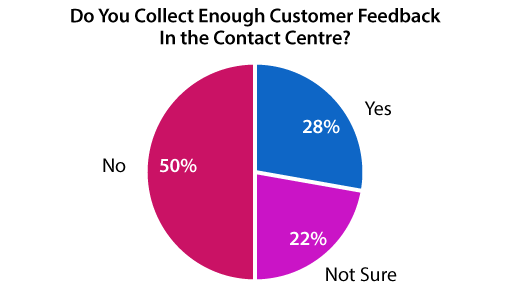
This poll was taken during our webinar: Customer Feedback Strategies That You Cannot Ignore
But collecting an adequate amount of feedback isn’t the only concern. We also worry that contact centres aren’t taking the necessary time to collate and communicate customer feedback across the business.
As Janette Coulthard of Pole Star Coaching says: “How these brands collect, collate, communicate and utilize the customer service feedback is key to driving growth, profitability and getting ahead of the competition.”
But how can you use customer service feedback in the contact centre to better engage your customers?
Well, one simple method is to follow the customer service feedback loop…
What Is the Customer Service Feedback Loop?
Most organizations will have a customer service feedback strategy, but a good strategy will address each of the four areas included in the feedback loop below.
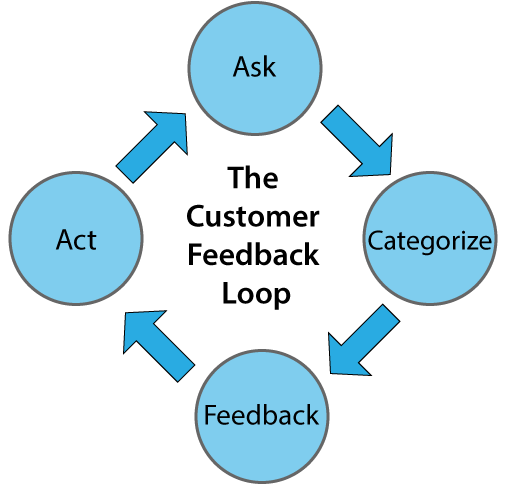
So let’s take a quick look at each stage that’s highlighted in this diagram to ensure that we are not missing any key fundamentals in our current customer service feedback strategies.
- Ask your customers for feedback or monitor what they are saying. This is the obvious first stage, but you want to do so at key points within the customer journey, which can make or break customer loyalty.
- Categorize the feedback that you collect and filter the insights, which can be distributed to different the areas of the business accordingly, so each department receives relevant insights.
- Follow up with your customers who shared feedback with you, because if you don’t, you may not get feedback in the future.
- Act on the feedback, as that will demonstrate to customers that you are listening to them. You should also monitor the impact of the actions that you have taken. This will demonstrate to the business that what you are doing is having a positive impact.
Just Remember, Asking Customers for Feedback Has Its Drawbacks
Unless they have an amazing or horrible experience with your company, customers are unlikely to voluntarily provide feedback. This means that the contact centre misses out on the thoughts of the silent majority.
A good customer feedback strategy will gather the opinions of this silent majority, as these are the customers that will give you the most constructive feedback…
A good customer feedback strategy will gather the opinions of this silent majority, as these are the customers that will give you the most constructive feedback – as opposed to your delighted customers or your very dissatisfied customers, who have already likely left.
The most popular methods for acquiring customer service feedback, however, are customer satisfaction (CSat) or Net Promoter Score (NPS) surveys. But you must recognize that they do have their limitations.
“These methods can tell you whether something is good or bad, but as to the ‘why?’, not so much!” says Janette.
There is also a problem with the scales to questions that traditional surveys ask, as most look for responses on a scale from 1–5, 1–7 or even 1–10.
Discussing this issue, our reader Sara says: “We have a 1–3 scale for exactly that reason. It’s easier to understand for customers.”
“Yes your service was great, it was up to par, and it did not meet expectations. Really, what does a seven out of ten mean? Smaller scales are much easier to understand.”
With this in mind, let’s now take a closer look at some of the other flaws within conventional customer service feedback questions…
The Traditional Customer Service Feedback Questions
If you want to collect metric scores that you can benchmark to assess the strength of your customer service and overall business offering, the chances are that you will ask one of the following three questions. In fact, you may ask more than one.
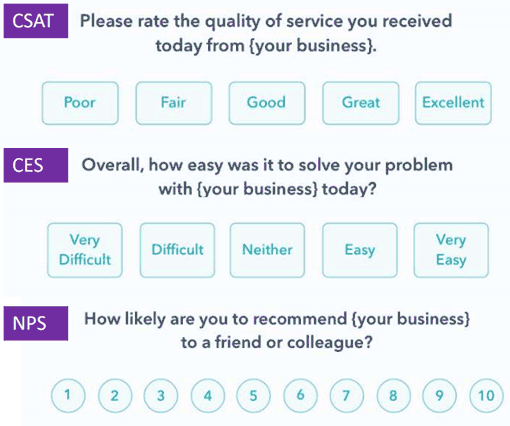
Through benchmarking, you can gain lots of great insights. But, Janette reminds us: “Surveys are not ‘King’. There are other rich sources of feedback – within the contact centre – that are created without taking any action. You just need to monitor and analyse.”
Just from monitoring conversations, listening to your social feeds and engaging with your customers, you can pick up lots of great insights.
The message here is not just to think that you have to stick to asking these customer service feedback questions to generate customer experience metrics. There are lots more ways to do it.
Listen to well-respected customer experience consultant Morris Pentel share his strong views on the future of traditional survey-based methods of collecting customer feedback in the following episode of The Contact Centre Podcast.
The Contact Centre Podcast – Episode 11:
Is It Time To Rethink Your Call Center Metrics?
For more information on this podcast visit Podcast: Is It Time to Rethink Your Call Centre Metrics?
9 Other Methods to Collect Customer Service Feedback
“Survey fatigue”. “Junk mail”. “Spamming”. These terms are now mainstream and are associated with lots of different organizations.
Why? Because too many organizations are relying on surveys as their principle method of collecting customer service feedback. Instead, it would be better to try different approaches and lower the number of surveys that you send to customers.
With this in mind, Janette has outlined nine other methods below that will enable you to gain fresh insights into both your contact centre and your customers.
1. Customer Panels
To set a customer panel up, first send invitations to customers. This makes them feel special and gives you a group of customers willing to provide feedback on an ongoing basis.
Once they have agreed, send them a few questions to gather their customer service feedback each year, with small incentives along the way to keep the panellists engaged in the process.
Just be careful to check the profile of panellists against the profile of your whole customer base to ensure there is no bias – with a mix of brand promoters, passives and detractors to your business.
2. Community Groups
Community groups where customers can talk to one another in a shared space enable you to monitor their conversations and spot areas to improve customer experience…
Community groups where customers can talk to one another in a shared space enable you to monitor their conversations and spot areas to improve customer experience – all while customers help to solve each other’s problems.
While these are often seen as risky and time-consuming to manage, you can create customer ambassadors for your product and let them manage the conversations (if you are brave enough).
3. Customer Listening Sessions
Customer listening sessions (also known as customer focus groups), alongside customer interviews, enables you to engage in open conversations with customers – who you have specially invited – regarding certain areas of your customer service.
These are particularly useful for drilling down deeper into the detail, and there is nothing better than hearing from a customer first hand, face-to-face or on a call.
4. Employee Listening Sessions
When organizations attempt to identify customer problems, they often forget that contact centre advisors will often know what they are.
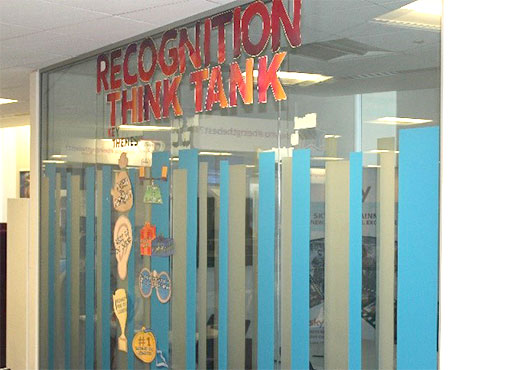
Sky’s contact centre designates this room for employee focus groups.
So, while you engage in customer listening sessions and interviews, you can also do the same with the contact centre team – who will be able to give you a whole variety of customer perspectives. You also won’t have to organize time with customers. Genius.
5. Social Media Polls
Creating polls on social media sites – including Instagram, Facebook and Twitter – can be great for testing the water, in terms of gauging your customers’ response to new ideas.
Another example of how you could use this to engage customers is by asking them to choose the best name for a new product or feature. Just be careful of customers suggesting “Feature McFeatureFace”…
6. WiFi Surveys
There are other ways to gather customer service feedback than just in the contact centre alone, and there a number of interesting methods that you can use if you have retail outlets or a high street presence.
You can trigger a quick survey whenever anybody tries to log on to your WiFi, or you can be more traditional and opt for feedback cards.
For example, you can trigger a quick survey whenever anybody tries to log on to your WiFi, or you can be more traditional and opt for feedback cards.
Just remember, though, this will only work when the company collecting the feedback has locations that customers visit – e.g. cinemas, hotels and restaurants.
7. Social Listening
There are other rich sources of customer feedback which are less intrusive for the customer, and these are gaining lots of momentum in this era when brands are focusing on making customer experience as easy as possible.
One of these is social listening, which allows you to find and filter social media conversations that reference your brand. In fact, you can use applications that alert you if your brand is mentioned – so you can gain real-time customer service feedback.
8. Review Live Chat Transcripts and Call Recordings
There is lots of great customer service feedback within chat transcripts and other useful insights, such as finding out which questions customers repeatedly ask.
You can also do this with recorded calls and, with the addition of speech analytics, you can pull out lots of great customer service feedback, finding helpful hints to where advisors may need increased support.
9. Record Website Visitor Session Replays
This method of gathering customer service feedback involves technology that enables you to watch replays of customer visits to your website, which will provide you with lots of great insights.
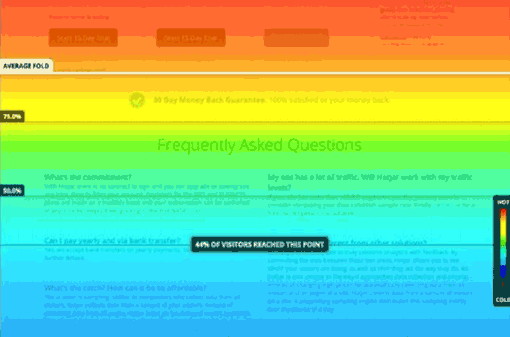
In fact, this technology allows you to create, move and scroll across heat maps – like in the image above – providing a wealth of data about how customers/visitors use your website and pointers for improvement.
For more methods of gaining customer service feedback, read our article: 25 Good Customer Feedback Examples
Getting Your Timing Right When Gathering Customer Service Feedback
While some of the methods above do not require customer input, many customer feedback strategies do. So, getting the timing of your customer surveys and customer contacts right becomes crucial.
Yet many organizations make the mistake of only asking for feedback at the point of acquisition, i.e. from the point of sale through to the onboarding process.
The graph below will help you to see how this only covers a small part of the customer journey.
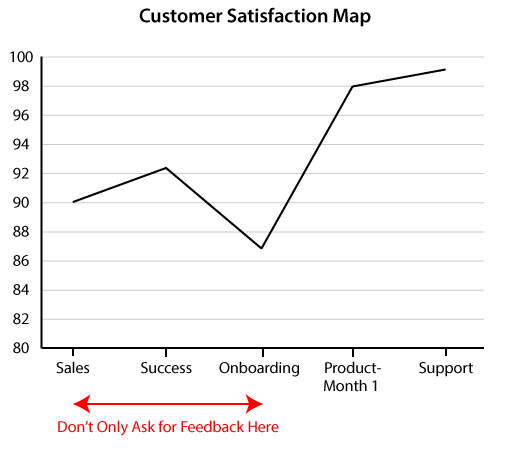
Instead, you want to be asking for feedback at key points throughout the customer life cycle, as that will give you deeper insights.
If you’ve designed your customer journeys to deliver great service at certain touchpoints, you want to be asking for feedback there – where it is most valuable in your efforts to create a memorable customer experience.
In addition to this, Janette recommends: “Creating a map of CSAT, CES & NPS scores – over the full customer life cycle – helps to identify areas in your customer life cycle/journey that need work (just like in the graph above).”
“Doing this helps to drive more powerful strategies, whether your key focus is acquisition, customer value growth or loyalty and retention.”
The Value of Categorizing Customer Service Feedback
Let’s just go back to our customer service feedback loop for a moment. We’ve put forward methods to ask for customer feedback, now you just need to have a system for categorizing it.
As you might have some success in trying out new methods for obtaining feedback, it’s wise to have a scalable system that can better cope with business growth and add categories.
But what exactly is the value of categorizing customer service feedback?

Janette Coulthard
Well, according to Janette: “Categorization enables easy analysis and how you categorize is critical to ensuring the data gets to the right person and action can be taken.”
Thinking about Janette’s point here, three categories already become clear in how you should divide feedback. They are:
- Product
- Customer Service
- Marketing and Sales
If you divide feedback like this, you can serve it up on a plate to other departments, so they recognize the value of the contact centre and, more importantly, can make moves to improve customer experience.
You can even go one step further and break down each main category into subcategories to enable prioritization of action to address the issues you identify.
For example, for feedback relating to product, you can filter the product category into subcategories including:
- Major product flaws or bugs – Urgent issues that prevent customers getting the core value out of your product.
- Minor product flaws or bugs – For minor issues that don’t distract from your core product value.
- Feature requests – Requests covering ideas for additional features or functionality requested by your customers.
It can be very useful to create categories like this for spreading customer insights into the wider organization, which can be a very valuable business tool.
For more on spreading feedback into the wider organizations, read our article: Drive the Voice of the Customer Into the Business for Real Change
Following Up Customer Service Feedback
Once you have categorized your feedback, it is time to follow up with customers who have taken time out of their day just to give you feedback. However, this is a key step that many organizations often bypass, as it takes effort and the benefits aren’t immediately tangible.
The thing is that customers want to know that you are listening, and showing them that you are by responding to their feedback helps to create more engaged and happy customers.
It also helps to generate ongoing feedback. Customers will think: ‘You heard me, so I’ll continue sharing’…
“Critically, it also helps to generate ongoing feedback. Customers will think: ‘You heard me, so I’ll continue sharing’,” adds Janette.
But what practical methods can you use to systematically respond to customer service feedback?
Well, you can try following any of the five suggestions below and maybe even mix them up to keep participating customers continually engaged with your brand.
- Follow up with thank you emails (personalized if possible)
- Thank you gifts (e.g. vouchers, corporate branded items, badge of honour, invite to become an ambassador)
- Display board on website – ‘You told us XYZ, we did XYZ’ (works particularly well for product features, changes or new products)
- ‘Shout out’ in newsletters or blogs
- Display customer reviews/recommendations on your website
By implementing one or more of these strategies, you can do more do create great relationships with your customers and safeguard your customer service feedback programme, so customers continue to contribute.
At the very least, you should be responding to negative customer service feedback to help turn a negative situation – in which you’d likely lose a customer – around.
To follow up with detractors in her contact centre, our reader Dianne has set up an “automated email notification, if the customer gives a score of six or less (NPS) to trigger a follow-up process.”
Find more expert advice on strengthening customer relationships in our article: What Is Stopping You From Creating Great Customer Relationships?
Now It’s Time to Act!
The final stage of your customer service feedback loop is to act on the feedback that you have asked for, categorized and followed up.
Acting on the feedback you have received, both good and bad, is clearly important, so you want to create a strategy around how to do so, in order to gain maximum value from your customer insights.
The first stage here is a simple one and that is to acknowledge that you may not need or be able to act on all feedback.
Then, as Janette says: “We need to ensure that other departments – not just our colleagues in customer service – are happy with the format and frequency that we are sending over customer insights in. It may be different for each department.”
We need to ensure that other departments – not just our colleagues in customer service – are happy with the format and frequency that we are sending over customer insights in.
“This is to just make sure you know who should receive the feedback and can drive actions to improve the customer experience.”
Once you have achieved this, it is great to give somebody the responsibility of overseeing this process and agreeing actions to be taken with the relevant people.
This person can then be in charge of tracking the progress and completion on the action, as well as monitoring the impact that it had.
Final Thoughts
Considering all of the information that we have put forward in this article, ask yourself: is our feedback strategy working as well as it could?
Look at how you can enhance what you have already and avoid some of those key customer service feedback mistakes that we have discussed, such as trying to continuously track feedback at insignificant customer touchpoints.
But, most importantly, you want to reflect on your customer service feedback loop and make sure that you have a clear strategy that covers each of the four stages.
If so, you will be able to drive your feedback across multiple departments, enabling them to make changes that will really help to improve customer experience.
Good luck!
For even more insights into managing customer service feedback in the contact centre, read our articles:
- 9 Ways to Encourage Customers to Give Feedback
- How to Use Customer Feedback to Improve Journey Maps
- 19 Reasons Why Collecting Customer Feedback Is Important for Your Organization
Author: Robyn Coppell
Published On: 3rd Jun 2020 - Last modified: 28th Jun 2024
Read more about - Customer Service Strategy, Customer Service, Customer Surveys, Editor's Picks, Feedback, Janette Coulthard, Morris Pentel, Voice of the Customer





















